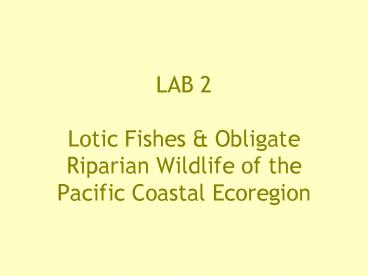LAB 2 Lotic Fishes - PowerPoint PPT Presentation
1 / 71
Title:
LAB 2 Lotic Fishes
Description:
Anadromy adult migrates to the sea for feeding, and returns to ... American dipper (Cinclus mexicanus) Painted ... River otter (Lutra canadensis) ... – PowerPoint PPT presentation
Number of Views:83
Avg rating:3.0/5.0
Title: LAB 2 Lotic Fishes
1
LAB 2Lotic Fishes Obligate Riparian Wildlife
of the Pacific Coastal Ecoregion
2
Salmonidae
- Anadromy adult migrates to the sea for feeding,
and returns to freshwater for reproduction. - Homing -- the strong tendency to reproduce at the
natal site. - Semelparity -- senescence and mortality after the
first season of reproduction.
3
Body morphology
4
Life history forms
- Anadromous migrate from saltwater to freshwater
to spawn - Nonmigratory complete lifecycle in natal stream
- Fluvial Live, feed, and mature in mainstem of
rivers, migrate to tributaries to spawn - Adfluvial Live, feed mature in lakes, migrate
to streams to spawn
5
Abundance
- Greatest Abundance
- -Pink
- -Chum
- -Sockeye
- Lesser Abundance
- -Chinook
- -Coho
6
Chinook (Oncorhynchus tshawytscha)
7
Chinook
- Juveniles spend 3-12 months in freshwater, rear
in sloughs and side-channels - Adults spend 2-4 yrs in ocean
- Spawn in mainstem reaches
- Have black gums
- Largest Pacific salmon
8
Chinook (Oncorhynchus tshawytscha)
9
Coho (Oncorhynchus kisutch)
10
Coho
- Juveniles spend 1 year in freshwater, eat lots
of terrestrial inverts are very territorial - Adults spend 1-2 years in ocean
- Spawn in smaller rivers, tributaries
- Have white gums
11
Coho (Oncorhynchus kisutch )
12
Coho (Oncorhynchus kisutch )
13
Chum (Oncorhynchus keta)
14
Chum
- Juveniles migrate to estuaries within a few days
of emergence - Adults spend 2-3 years in ocean
- Found in most small coastal streams side
channels of larger rivers
15
Chum (Oncorhynchus keta )
16
Chum (Oncorhynchus keta)
17
Sockeye (Oncorhynchus nerka)
18
Sockeye
- Juveniles spend 1-2 years in freshwater, mostly
lakes - Adults spend 1-4 years in ocean
- Spawn in variety of habitats rivers, streams,
beaches and bottoms of lakes - Landlocked (non-anadromous) form kokanee
19
Sockeye (Oncorhynchus nerka)
20
Sockeye (Oncorhynchus nerka)
21
Pink/Humpy (Oncorhynchus gorbuscha)
22
Pink
- Juveniles migrate to estuaries immediately after
emerging, enter ocean after 3 mo. - Adults spend 2 years in ocean
- Smallest Pacific salmon
- Spawn in larger coastal rivers, usually found in
lower portion of the watershed
23
Oncorhynchus gorbuscha
24
Cutthroat trout (Oncorhynchus clarki)
25
Cutthroat
- Coastal subspecies is anadromous
- Also nonmigratory, fluvial adfluvial forms
- Found in large and small lakes and streams
26
Steelhead/Rainbow Trout (Oncorhynchus mykiss)
27
Steelhead/Rainbow
- Steelhead anadromous form (1-4 yrs in ocean),
Rainbow non-anadromous (nonmigratory, fluvial,
adfluvial) - Prefer fast-moving water in rivers, tributaries
and lakes - Spawn in spring and winter
28
Charr (Salvelinus spp.)
29
Charr
- Family Salmonidae
- Anadromous, nonmigratory, fluvial and adfluvial
forms - Typically benthic feeders
- Spawn in tributary streams
30
(Charr) Salvelinus spp.
31
Whitefish (Prosopium spp.)
32
Whitefish
- Family Salmonidae
- Fluvial
- Spawn in fall
- Dont build redds
33
Prosopium spp.
34
Sculpin (Cottus spp)
35
Sculpin
- Very speciose family (Cottidae)
- Usually found in small streams/lakes (especially
coastal streams) - Can be migratory
- Male guards eggs
36
Longnose Dace (Rhinichthys cataractae)
37
Minnows (e.g. Longnose Dace)
- Family Cyprinidae
- Nonmigratory
- Found in small stream riffles
- Lay adhesive eggs
- Eat chironomids
38
Rhinichthys cataractae
39
Longnose sucker (Catostomus catostomus)
40
Suckers
- Family Catostomidae
- Nonmigratory
- Found in cold, clear lakes and tributaries
- Bottom feeding plankton and invertebrates
41
Longnose sucker(Catostomus catostomus )
42
Olympic Mudminnow (Novumbra hubbsi)
43
Mudminnows
- Family Umbridae
- Nonmigratory
- Lay adhesive eggs (adhere to aquatic vegetation)
- Found in slow, marshy streams, bogs, swamps and
ponds with little flow and dense vegetation
44
Sturgeon (Acipenser spp.)
45
Sturgeon
- Family Acipenseridae
- Anadromous
- Largest bony fish in the world
- Prefer large rivers with swift currents and rocky
bottoms - Benthic feeders
46
Acipenser spp.
47
Lamprey (Lampetra spp.)
48
Lamprey
- Family Petromyzontidae
- Anadromous
- Spawn in riffles, die after spawning
- Found in low gradient streams
49
Lampetra spp.
50
Burbot (Lota lota)
51
Burbot/eelpout
- Family Gadidae
- Found in deep water of rivers and lakes
- Piscivorous
- Spawn in late winter at night in writhing masses
in shallow water
52
Three-spined stickleback (Gasterosteus aculeatus)
53
Stickleback
- Family Gasterosteidae
- Male digs nest, lines it with veg using glue from
kidneys, prods female to lay eggs, chases her
away, guards eggs young - Found in slow streams
- Benthic feeders
54
Common loon (Gavia immer)
55
Barrows goldeneye (Bucephalia islandica)
56
Harlequin duck (Histrionicus histrionicus)
57
Common merganser (Mergus merganser)
58
Belted kingfisher (Ceryle alcyon)
59
Bald eagle (Haliaeetus leucocephalus)
60
Osprey (Pandion haliaetus)
61
American dipper (Cinclus mexicanus)
62
Painted turtle (Chrysemys picta)
63
Aquatic garter snake (Thamnophis atratus)
64
Water shrew (Sorex palustris)
65
Fringed Myotis (Myotis thysanodes)
66
Muskrat (Odatra zibethicus)
67
Beaver (Castor canadensis)
68
River otter (Lutra canadensis)
69
Mink (Mustela vison)
70
Columbia White-Tailed Deer (Odocoileus virgianus
leucurus)
71
Roosevelt elk (Cervus elaphus roosevelti)































